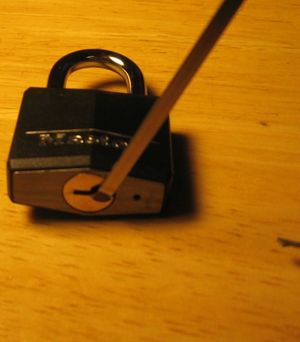Lock picking is made out to be more difficult than it is. There is an art to it, true. Good locks are much harder to pick, true. There are several types of locks that are an incredible pain to pick, but they are not the kind of lock you will encounter day-to-day. For instance, I originally learned to pick a desk lock that I had lost the key to.
One excellent place to learn more is lock picking clubs. They are often located at universities and colleges, and they usually accept non-students as well. This gives you access to experts who can help you advance your technique, a variety of locks to practice on, and a network of friends. This is very much an above-board sport – there are lock picking competitions each year, there are clubs who enjoy the sport of it, and there are locksmiths who do this for a living. It is an amazingly useful skill – the next time you have a lock you have lost the key for, or you break a key in a lock, you can avoid a call to the locksmith.
The first part of lock picking is a mental exercise. Imagine a steel bar, standing vertically, with a circular hole drilled in it. Now imagine that the hole has a steel rod in it. This is called the cylinder The rod can rotate freely in the hole. Now imagine that there are a series of notches cut along the length of that steel rod, with tiny rods inside the notches. These tiny rods go between the cylinder and the bar and keep the cylinder from rotating. The tiny rod in the notch is called a pin. Pins have a cut somewhere along their length. There are springs in the bar to push the pins into the cylinder. Please note, however: it’s not the springs that prevent the cylinder from turning, it’s the cylinder binding up on the pin.
So, imagine that there is only one pin. There is a split halfway along the length. All you must do to allow the cylinder to turn is lift the pin halfway with a tool, called a pick. The cut on the pin will meet the interface between the cylinder and bar, and the cylinder will rotate. This is the basic principle behind lock picking.
Real locks, however, are not that simple. Let’s now imagine that there are two pins. One has a cut one third of the way along its length, the other two thirds of the way. This poses an interesting problem – we can only lift one pin at a time. When we let go of one pin to lift the other, the spring will push the pin back out of the way. The solution is torsion. At these sizes, metal acts a bit like a spring, so it’s helpful to imagine it as a spring. If you try to rotate the cylinder, then lift the first pin, the cylinder will rotate immeasurably and hold the pin in place. You are bending the metal a tiny tiny amount. You can now slide the pick back and lift the second pin. As that pin catches, the lock will perceptibly “give.” Now you must lift the first pin again slightly, and the lock should give. It all depends on the exact lock, and how the pins move – some locks will need to be babied and require repeated slight adjustments of the pins, some will catch right away.
For reference, locks in real life will usually have four to six pins, usually five. Now on to the practical aspects of lock picking. You will be better off buying tools your first time. Some people make them, and this is possible, but you wouldn’t make a hammer before you knew how to work one, would you? If you buy only one pick, buy a hybrid half-diamond pick. It looks like a triangle (a half-diamond) canted at a 45* angle (this is the hybrid part). I have one below. It is the most versatile pick and definitely my personal favorite for all techniques. If you can buy only two picks, buy a flat pick. It ends in a flat side. This allows you to press on a single pin at a time. You will also need to buy a torsion wrench. It looks like a thin bar with a 90* turn. What I have below is a compact pick set – it has four picks and a torsion wrench in a package that’s about the size of a cigarette lighter. Individual picks normally cost about $2-3.
Insert the torsion bar first, on the side of the lock that is away from the pins. In my picture below, the pins are on the left, so the torsion bar goes in the right side of the lock. Always insert the torsion bar behind the rotation of the lock. In this case, the lock rotates clockwise, so the torsion bar goes above the lock. Pick the lock up, and rest your thumb about halfway along the length of the torsion bar. Apply a gentle pressure, and slide the pick all the way to the back. Push each pin down slowly in turn. This is the part that’s an art – too much torsion and the pin won’t push down. Too little torsion and none of the pins will catch. It takes practice and every lock is different. As you go, increase the torsion slightly – very small amounts with each pin. Keep unlocking each pin as you go from back to front – this is the core lock picking technique.
I recommend buying a variety of locks to practice on. Each lock is different and if you don’t practice on a variety you will soon learn the characteristics of the lock – which pin releases first, the perfect amount of force to apply with the torque wrench, and so on. These characteristics are different for each lock, so you will need to practice on a variety. One option that is very effective at first is to buy a Qwikset lock at Home Depot for about $15. You can then disassemble the lock and remove some of the pins. This will make it easier to practice at first, and you can add the pins back later. You can also switch the pins around into different sockets, this is excellent practice.
Please take note: in most states, committing a crime while in possession of lock picks adds possession of burglary tools to your charges. On this note, please be aware of the laws at your location. For instance, owning picks in the Netherlands is illegal, period. Like owning a crowbar or firearms, lock picks are amazingly useful and fun when used legally, but they can be used for harm as well. Please don’t be the person that wrecks this wonderful sport for all of us. I have never picked a lock that I didn’t own (or without asking the owners first) and you shouldn’t either. This is first and foremost about fun and skill, not crime.



